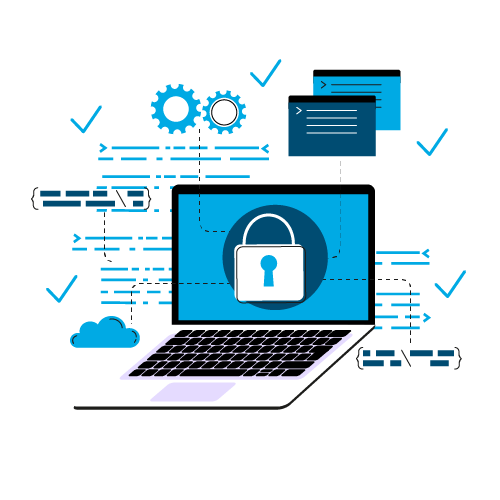As we move further into the digital age, the landscape of cybersecurity is evolving at an unprecedented pace. The integration of advanced technologies such as artificial intelligence, machine learning, and the Internet of Things (IoT) is both enhancing our capabilities and introducing new vulnerabilities. In this blog post, we’ll explore the future of cybersecurity, focusing on predictions for the next decade, emerging trends, and the technologies that will shape this critical field.
The Future of Cybersecurity
The future of cybersecurity is a topic of immense importance as we look ahead to the next decade. With cyber threats becoming increasingly sophisticated, the need for robust cybersecurity measures has never been more urgent. Here’s what we can expect:
1. Increased Use of Artificial Intelligence and Machine Learning
Artificial Intelligence (AI) and Machine Learning (ML) are set to revolutionize the cybersecurity landscape. These technologies can analyze vast amounts of data at high speeds, identifying patterns and anomalies that may indicate a cyber threat. In the next decade, AI and ML will become integral in threat detection, response automation, and predictive analytics.
Predictive Threat Intelligence: By analyzing historical data and current threat landscapes, AI will predict potential cyber-attacks before they occur, allowing organizations to take proactive measures.
Automated Incident Response: AI-driven systems will enable automated responses to cyber threats, reducing the time taken to mitigate attacks and minimizing damage.
2. The Rise of Quantum Computing
Quantum computing holds the potential to crack traditional encryption methods, posing a significant threat to current cybersecurity protocols. However, it also offers new opportunities for developing advanced cryptographic techniques.
Quantum-Resistant Encryption: As quantum computing becomes more mainstream, the development and implementation of quantum-resistant encryption methods will be crucial to protect sensitive data.
Enhanced Security Protocols: Quantum technology will also enhance security protocols, making them more robust against advanced cyber threats.
3. Expansion of the Internet of Things (IoT)
The proliferation of IoT devices is expanding the attack surface for cybercriminals. With billions of interconnected devices, ensuring their security will be a monumental task.
IoT Security Standards: The establishment of standardized security protocols for IoT devices will be essential to mitigate vulnerabilities.
Device Authentication: Implementing strong authentication mechanisms for IoT devices will help prevent unauthorized access and control.

Cybersecurity Trends 2030
As we look towards 2030, several key cybersecurity trends are expected to dominate the landscape. These trends will shape the strategies and technologies employed to protect against evolving threats.
1. Zero Trust Architecture
The Zero Trust model operates on the principle that no entity, whether inside or outside the network, should be trusted by default. This approach is gaining traction as organizations recognize the need for stringent access controls.
Micro-Segmentation: Dividing the network into smaller, isolated segments to contain potential breaches and limit lateral movement of attackers.
Continuous Verification: Implementing continuous authentication and verification processes to ensure that only authorized users have access to sensitive information.
2. Enhanced Data Privacy Regulations
With increasing concerns over data privacy, regulatory bodies worldwide are enacting stricter data protection laws. Organizations will need to comply with these regulations to avoid hefty fines and reputational damage.
Global Data Protection Standards: Harmonizing data protection standards across different jurisdictions to simplify compliance for multinational organizations.
Data Minimization: Collecting and storing only the necessary data to reduce the risk of exposure in the event of a breach.
3. Cybersecurity Workforce Development
The demand for skilled cybersecurity professionals will continue to grow, leading to increased investment in education and training programs.
Upskilling and Reskilling: Providing continuous learning opportunities for current employees to keep pace with evolving cyber threats.
Diverse Workforce: Encouraging diversity in the cybersecurity workforce to bring varied perspectives and innovative solutions to the field.
Next Decade in Cybersecurity
The next decade will witness significant advancements in cybersecurity, driven by technological innovations and evolving threat landscapes. Here are some key predictions:
1. Integration of Cybersecurity with Business Strategy
Cybersecurity will no longer be viewed as a standalone IT function but will become an integral part of overall business strategy. Organizations will recognize the importance of embedding security into every aspect of their operations.
Board-Level Involvement: Increased involvement of board members and executives in cybersecurity decision-making processes.
Security by Design: Incorporating security considerations into the design and development of products and services from the outset.
2. Focus on Cyber Resilience
As cyber-attacks become more frequent and sophisticated, organizations will shift their focus from mere prevention to building cyber resilience.
Incident Response Planning: Developing and regularly testing comprehensive incident response plans to minimize the impact of cyber-attacks.
Continuous Monitoring: Implementing advanced monitoring tools to detect and respond to threats in real time.
3. Emergence of Decentralized Security Models
The rise of blockchain and decentralized technologies will pave the way for new security models that are more resilient to attacks.
Blockchain for Security: Utilizing blockchain technology to create immutable and transparent records of transactions and events, reducing the risk of tampering and fraud.
Decentralized Identity Management: Implementing decentralized identity solutions to enhance user privacy and control over personal data.

Cybersecurity Predictions
Predicting the future of cybersecurity is challenging, given the rapidly evolving threat landscape. However, several key trends and technologies are likely to shape the field in the coming years.
1. Biometric Authentication
Traditional passwords are increasingly seen as insufficient for securing sensitive information. Biometric authentication methods, such as fingerprint scanning and facial recognition, will become more prevalent.
Multi-Factor Authentication (MFA): Combining biometric authentication with other methods, such as tokens or passwords, to provide an additional layer of security.
Behavioral Biometrics: Analyzing user behavior, such as typing patterns and mouse movements, to detect anomalies and potential threats.
2. Advanced Threat Detection and Response
The use of AI and ML in threat detection will continue to grow, enabling organizations to identify and respond to threats more quickly and accurately.
Anomaly Detection: Leveraging ML algorithms to detect deviations from normal behavior that may indicate a cyber threat.
Threat Hunting: Proactively searching for signs of potential threats within the network, rather than relying solely on automated tools.
3. Increased Collaboration and Information Sharing
Collaboration between organizations, governments, and cybersecurity vendors will be essential to combat cyber threats effectively.
Threat Intelligence Sharing: Participating in threat intelligence sharing programs to stay informed about the latest threats and vulnerabilities.
Public-Private Partnerships: Establishing partnerships between the public and private sectors to enhance collective cybersecurity efforts.
Emerging Cybersecurity Technologies
The development of new technologies will play a crucial role in shaping the future of cybersecurity. Here are some emerging technologies that are expected to have a significant impact:
1. Secure Access Service Edge (SASE)
SASE is a network architecture that combines wide-area networking (WAN) capabilities with comprehensive security functions. It provides secure access to applications and services, regardless of the user’s location.
Cloud-Native Security: Implementing security measures that are built into the cloud infrastructure, rather than relying on traditional perimeter-based security.
Unified Security Management: Integrating various security functions, such as firewall, intrusion prevention, and secure web gateway, into a single platform.
2. Homomorphic Encryption
Homomorphic encryption allows data to be encrypted and processed without being decrypted, enhancing data privacy and security.
Secure Data Processing: Enabling secure computation on encrypted data, reducing the risk of exposure during processing.
Privacy-Preserving Analytics: Allowing organizations to analyze encrypted data without compromising privacy, making it ideal for sensitive information such as healthcare records.
3. Deception Technology
Deception technology involves creating decoys and traps within the network to detect and divert attackers.
Honeypots and Honeynets: Deploying fake systems and networks that mimic real assets to lure attackers and gather intelligence on their tactics.
Deceptive Credentials: Using fake credentials and access points to mislead attackers and monitor their activities.

Conclusion
The future of cybersecurity is both promising and challenging. As we look towards the next decade, the integration of advanced technologies, the adoption of new security models, and the development of a skilled workforce will be critical in combating evolving cyber threats. By staying ahead of the curve and embracing innovation, organizations can build robust defenses and ensure the security of their digital assets.
In this dynamic and ever-changing landscape, vigilance and adaptability will be key. The predictions and trends outlined in this blog post provide a glimpse into the future of cybersecurity, highlighting the need for continuous evolution and proactive measures. As we navigate this complex terrain, one thing is certain: the future of cybersecurity will be defined by our ability to anticipate, innovate, and collaborate in the face of emerging challenges.
If you are looking for an experienced IT provider, H&L Consulting is the best option. With years of experience, we specialize in mobile app development, web app development, staff augmentation, and robot process automation. Our staff of over 30 highly qualified IT consultants and developers can handle projects of any scale. We are committed to supporting your goals after successfully delivering over 50 solutions to clients throughout the world. Contact us for a full discussion, knowing that H&L Consulting is prepared to fulfill all your IT demands with specialized, effective solutions.









